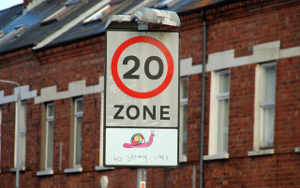Do 20mph Speed Limits Work?

Since 1935, up until most recently the UK’s national speed limit has been 30mph for built-up areas, in Wales all urban roads have the default speed limit of 20mph and now several areas around the country have followed suit. However, its effectiveness is debatable and requires analysis as the number of private and motor trade vehicles on our roads continue to increase.
20mph Speed Limit History
The 20mph speed limit was introduced in the UK in 1991 in Tinsley, Sheffield, since then, many roads have introduced this speed limit, including some boroughs around London. In 2020 the central Congestion Charge zone also changed to the reduced speed limit, and Transport for London has plans to have 137 miles of road ruled by the 20mph speed limit by 2024.
Wales is planning to have all urban roads also within this limit by September 2023, while Scotland has initiated plans to achieve the same by 2025.
Case for a 20 mph Speed Limit
Campaigners of the 20mph speed limit make a strong argument, as it addresses the main challenge of improving road safety for everyone, especially pedestrians, cyclists, and other vulnerable road users.2021 reported 16,608 pedestrians were injured and 364 deaths on our nation’s roads. 16,479 cyclists sustained injuries while 113 succumbed to the accidents.
Transport For London reported that in 37% of collisions, speed is the primary reason for deaths and serious injury, which was the reason behind the decrease of London’s speed limit to 20mph and is part of the Mayor’s Vision Zero policy of no deaths or serious injury on London roads by 2041.
Collisions are more likely to occur when a driver has limited time to react, the greater the speed, the higher chance of serious injury or death. Collisions at 30mph are five times more likely to lead to death than at 20mph.
The 20mph speed limit also encourages a healthier lifestyle of cycling and walking, reduces vehicle usage and limits traffic on the roads, helping the environment.
Imperial University evaluated 20mph zones in London and concluded they had no net negative impact on exhaust emissions. There was a smoother movement of vehicles than in 30mph zones which reduces particulate emissions from tyre and brake wear, information parts of the motor trade industry will probably already be aware of.
To our knowledge, no research has been carried out on motor trade insurance brokers and companies to evaluate the impact the reduced speed limit has on private and motor trade insurance policies.
Case Against 20 mph Speed Limits
The main challenge of having a lower speed limit is that motorists rarely obey them, 87% of motorists broke the 20mph speed limit in 2021, while 51% exceeded the 30mph speed limit according to the Government official statistics. This indicates motorists are not quite compliant with the 20mph speed limit.

One Thames Valley Police traffic management officer warned of the compliance during a consultation in Oxfordshire. When a speed limit is too low, it is ignored and brings the speed limits systems to be in dispute, drivers can also easily criminalise themselves.
Additionally, the 20 mph increases vehicle time on the road by 3% in residential areas and 5% in urban areas.
In summary, despite the ongoing debate, let’s not forget that breaking any speed limit normally attracts fixed penalty points and a fine, which makes things more difficult for motorists when it comes to renewing their insurance policy.
Interestingly, Wandsworth Council are fining motorists £130 without the addition of penalty points in some cases, this is part of an eight-month pilot scheme in the area.






